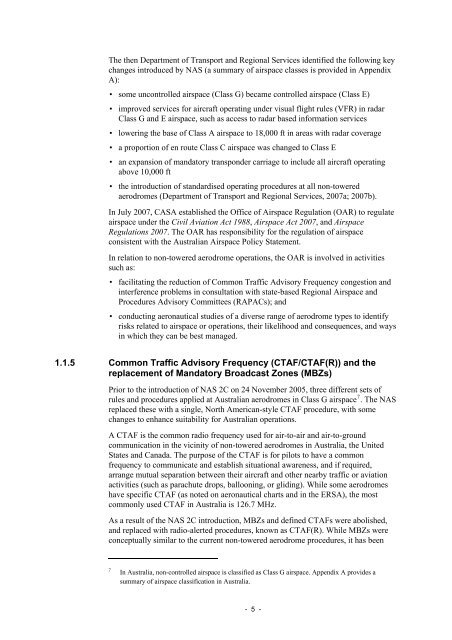Safety in the vicinity of non-towered aerodromes - Australian ...
Safety in the vicinity of non-towered aerodromes - Australian ...
Safety in the vicinity of non-towered aerodromes - Australian ...
Create successful ePaper yourself
Turn your PDF publications into a flip-book with our unique Google optimized e-Paper software.
The <strong>the</strong>n Department <strong>of</strong> Transport and Regional Services identified <strong>the</strong> follow<strong>in</strong>g key<br />
changes <strong>in</strong>troduced by NAS (a summary <strong>of</strong> airspace classes is provided <strong>in</strong> Appendix<br />
A):<br />
• some uncontrolled airspace (Class G) became controlled airspace (Class E)<br />
• improved services for aircraft operat<strong>in</strong>g under visual flight rules (VFR) <strong>in</strong> radar<br />
Class G and E airspace, such as access to radar based <strong>in</strong>formation services<br />
• lower<strong>in</strong>g <strong>the</strong> base <strong>of</strong> Class A airspace to 18,000 ft <strong>in</strong> areas with radar coverage<br />
• a proportion <strong>of</strong> en route Class C airspace was changed to Class E<br />
• an expansion <strong>of</strong> mandatory transponder carriage to <strong>in</strong>clude all aircraft operat<strong>in</strong>g<br />
above 10,000 ft<br />
• <strong>the</strong> <strong>in</strong>troduction <strong>of</strong> standardised operat<strong>in</strong>g procedures at all <strong>non</strong>-<strong>towered</strong><br />
<strong>aerodromes</strong> (Department <strong>of</strong> Transport and Regional Services, 2007a; 2007b).<br />
In July 2007, CASA established <strong>the</strong> Office <strong>of</strong> Airspace Regulation (OAR) to regulate<br />
airspace under <strong>the</strong> Civil Aviation Act 1988, Airspace Act 2007, and Airspace<br />
Regulations 2007. The OAR has responsibility for <strong>the</strong> regulation <strong>of</strong> airspace<br />
consistent with <strong>the</strong> <strong>Australian</strong> Airspace Policy Statement.<br />
In relation to <strong>non</strong>-<strong>towered</strong> aerodrome operations, <strong>the</strong> OAR is <strong>in</strong>volved <strong>in</strong> activities<br />
such as:<br />
• facilitat<strong>in</strong>g <strong>the</strong> reduction <strong>of</strong> Common Traffic Advisory Frequency congestion and<br />
<strong>in</strong>terference problems <strong>in</strong> consultation with state-based Regional Airspace and<br />
Procedures Advisory Committees (RAPACs); and<br />
• conduct<strong>in</strong>g aeronautical studies <strong>of</strong> a diverse range <strong>of</strong> aerodrome types to identify<br />
risks related to airspace or operations, <strong>the</strong>ir likelihood and consequences, and ways<br />
<strong>in</strong> which <strong>the</strong>y can be best managed.<br />
1.1.5 Common Traffic Advisory Frequency (CTAF/CTAF(R)) and <strong>the</strong><br />
replacement <strong>of</strong> Mandatory Broadcast Zones (MBZs)<br />
Prior to <strong>the</strong> <strong>in</strong>troduction <strong>of</strong> NAS 2C on 24 November 2005, three different sets <strong>of</strong><br />
rules and procedures applied at <strong>Australian</strong> <strong>aerodromes</strong> <strong>in</strong> Class G airspace 7 . The NAS<br />
replaced <strong>the</strong>se with a s<strong>in</strong>gle, North American-style CTAF procedure, with some<br />
changes to enhance suitability for <strong>Australian</strong> operations.<br />
A CTAF is <strong>the</strong> common radio frequency used for air-to-air and air-to-ground<br />
communication <strong>in</strong> <strong>the</strong> vic<strong>in</strong>ity <strong>of</strong> <strong>non</strong>-<strong>towered</strong> <strong>aerodromes</strong> <strong>in</strong> Australia, <strong>the</strong> United<br />
States and Canada. The purpose <strong>of</strong> <strong>the</strong> CTAF is for pilots to have a common<br />
frequency to communicate and establish situational awareness, and if required,<br />
arrange mutual separation between <strong>the</strong>ir aircraft and o<strong>the</strong>r nearby traffic or aviation<br />
activities (such as parachute drops, balloon<strong>in</strong>g, or glid<strong>in</strong>g). While some <strong>aerodromes</strong><br />
have specific CTAF (as noted on aeronautical charts and <strong>in</strong> <strong>the</strong> ERSA), <strong>the</strong> most<br />
commonly used CTAF <strong>in</strong> Australia is 126.7 MHz.<br />
As a result <strong>of</strong> <strong>the</strong> NAS 2C <strong>in</strong>troduction, MBZs and def<strong>in</strong>ed CTAFs were abolished,<br />
and replaced with radio-alerted procedures, known as CTAF(R). While MBZs were<br />
conceptually similar to <strong>the</strong> current <strong>non</strong>-<strong>towered</strong> aerodrome procedures, it has been<br />
7<br />
In Australia, <strong>non</strong>-controlled airspace is classified as Class G airspace. Appendix A provides a<br />
summary <strong>of</strong> airspace classification <strong>in</strong> Australia.<br />
- 5 -
















